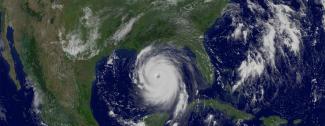When a hurricane blows through an area, it topples trees, upends lives, disrupts production and wreaks economic damage. But will it have a broader impact? A new study found that local changes affect the national economy differently depending partly on how much an area’s industries are connected to other sectors and regions. A disruption in the state California, which produces technology used across the United States, will likely have a larger impact on national GDP than one in the state of North Dakota.

When a hurricane blows through an area, it topples trees, upends lives, disrupts production and wreaks economic damage. But will it have a broader impact? A new study found that local changes affect the national economy differently depending partly on how much an area’s industries are connected to other sectors and regions. A disruption in California, which produces technology used across the nation, will likely have a larger impact on national GDP than one in North Dakota.
In the wake of a hurricane or an earthquake, we often hear about estimated costs in the tens of billions of dollars. There can also be positive economic “shocks” to a local economy as well—a boom prompted by the entry of firms or the discovery of natural resources, for example. The economic effects of such events are often obvious in the place where they happen, in the form of boom towns or fleets of repair trucks. But how do these local disruptions affect the United States’ overall economic activity?
It’s a question that hasn’t been investigated much, says Lorenzo Caliendo, an economics professor at Yale SOM. “The idea of thinking about how regional shocks propagate and how they affect our aggregate economy has not been explored much,” he says.
In a 2018 study, Caliendo, Fernando Parro, Esteban Rossi-Hansberg, and Pierre-Daniel Sarte fill this gap. The researchers investigated how shocks to particular regions and sectors might affect the national GDP and welfare, a measure capturing the real consumption of goods and services. The team found that individual states have very different effects on the national economy, depending partly on how much their industries support others. “You cannot ignore the spatial distribution of economic activity,” Caliendo says. The impact of a regional disruption on national GDP “is very heterogeneous across space.”
The researchers first examined each region’s contribution to the country’s overall GDP in 2007. They found substantial variation. For instance, California’s share was 14% and Texas’ 8%, while states such as South Dakota and Kansas provided less than 1% each. “Economic activity is spread across the U.S. unevenly,” Caliendo says. The differences weren’t driven purely by geographic size; factors such as how productive the state’s industries are also played a role.
Different sectors are dispersed across the country unevenly. The petroleum and coal industry, for example, was largely concentrated in California, Texas, and Louisiana. But the paper and wood industry was spread across a wider swath of states, suggesting that a disruption to that sector would reverberate throughout the country. When the researchers analyzed national productivity growth from 2000 to 2007, they found that regional changes accounted for 29% of the changes to aggregate productivity.
Next, the team created an economic model to better understand how different regions influenced the national economy. The model included entities such as industries, firms, workers who migrate among states, trade, land, and structures such as buildings and factories. Using data from the Bureau of Economic Analysis and the Commodity Flow Survey, the researchers could then compute a measure called elasticity. This measure captures how much a shock—and corresponding change in productivity—in a particular state affects the overall U.S. economy, controlling for the state’s size.
The team then ran the model to find out what would happen in hypothetical scenarios where each sector or region increased its productivity by 10%. The analyses revealed that elasticity varied considerably across states. For example, California’s elasticity was 1.3, while Florida’s was 0.89. That is, a productivity change in California increases national output 46% more than a productivity change of the same magnitude in Florida. California matters more to the national economy, not because of its size, but partly because its computer and electronics industry produces goods used by many other sectors in the economy. “California is producing inputs that matter for all of us,” Caliendo says. Florida, in contrast, focuses on industries that produce mostly final goods and services for local residents.
Finally, the researchers analyzed several case studies. One was the computer and electronics boom in California from 2000 to 2007. Using the model, the team estimated that the state’s rise in productivity boosted U.S. welfare by 0.2% per year. For comparison, a 2015 study by Caliendo and Parro suggests that the North America Free Trade Agreement (NAFTA) increased the country’s welfare by only 0.1% annually. So this local shock in California “generated considerable effects for the U.S. economy,” he says.
By contrast, a boom in North Dakota had relatively little impact on the rest of the country. Locally, the economy benefited from growth in shale oil extraction. But this productivity change increased U.S. welfare by only 0.01%, the team estimates. One reason is that North Dakota doesn’t trade much with other states, Caliendo says.
Policymakers could use the model to help decide where to invest in infrastructure. For example, the team estimated that the devastation caused by Hurricane Katrina in Louisiana, Mississippi, and Alabama reduced U.S. welfare by 0.24% and GDP by 0.12%, a sizable amount. Using these measures, government agencies could determine which regions are the most crucial to the national economy and prioritize infrastructure improvements in those areas.
Individual businesses should also keep in mind that they may be vulnerable to disruptions in faraway states. “Don’t ignore these indirect linkages in which you might be exposed to shocks,” Caliendo says.

